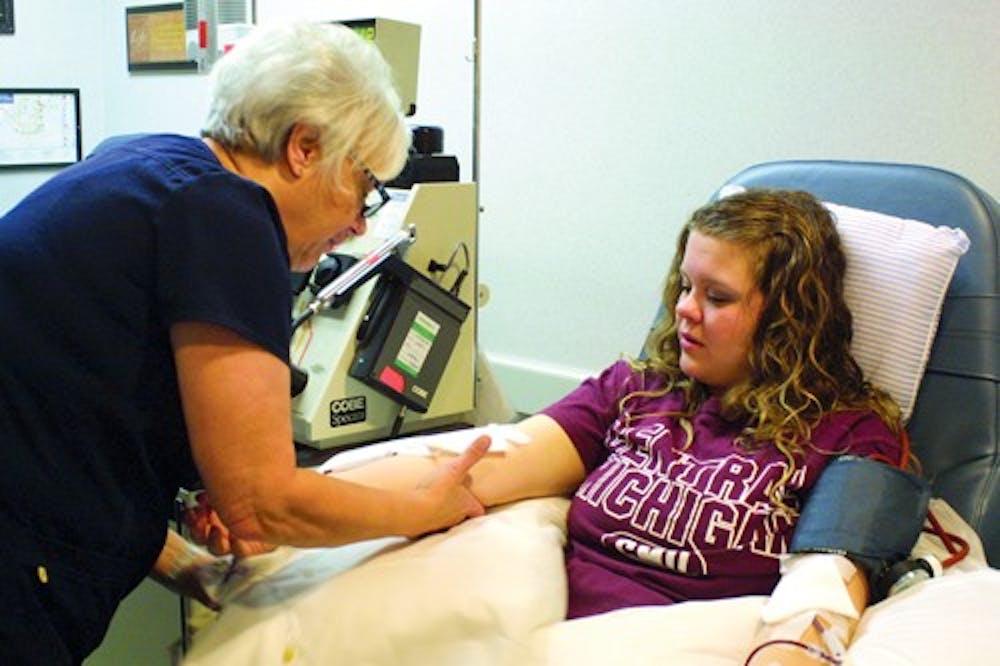Student's bone marrow donation initiates CMU campaign
GRAND RAPIDS — Ever since she was told she was a match to donate bone marrow and could save a life, Jennifer Eskridge hasn't second guessed her decision.
“I never had a doubt that I would not do it,” the Lapeer sophomore said. Eskridge went on to discuss the importance of bone marrow donation as she made the snowy drive from Mount Pleasant to Grand Rapids on March 1 for her initial round of injections prior to donating. “How do you say 'yes or no' to saving somebody else’s life?”
According to the U.S. Department of Health and Human Services, roughly 20,000 people each year are in need of bone marrow or some other type of blood cell transplant. However, only about one in 540 people on the Be The Match registry end up being an eligible match to someone in need.
Eskridge’s journey began when a member of her church died in 2011 and a blood drive was held in his honor. The option to sign up for the Be The Match registry was also offered, and Eskridge saw no reason not to sign up the next year when she was unable to give blood.
“I found out I was a confirmed match on Feb. 10,” Eskridge said. “It’s been a little overwhelming, but I’m just trying to take it one step at a time.”
On March 5, Eskridge donated at the Michigan Blood in Grand Rapids for her 47-year-old male match.
As with all donations made through the national Be The Match registry, Eskridge's match must remain anonymous for the first year after the donation. After that, each center differs on levels of communication. Some allow anonymous updates, while others permit direct visits.
The entire donation of peripheral blood stem cells – the second of two options when donating through Be The Match – took between three and four hours, an uncommonly fast donation time. Eskridge was put up in a nearby hotel the night before her donation, free of charge.
According to Stem Cell Program Manager Barbara Hile, the average donation time typically lasts around six hours, depending on the donor’s weight and the amount of medication in his or her system. Eskridge received several rounds of injections in the days leading up to her donation that worked to multiply her white blood cell count and push those cells out of her bones and into her peripheral blood stream for collection.
Eskridge’s cell count on the day of donation was high, meaning her body accepted the medicine well. Her speedy donation was just what the doctor ordered.
“(The cells) leave the building as soon as she’s done,” Hile said. “The goal is to get those cells into the patient as soon as possible.”
Raising awareness
Hile, who is also a Central Michigan University alumna, plans to use Eskridge’s success as a gateway to raise awareness and achieve higher registry numbers on campus. While registry drives have been sporadic over the last few years, Hile hopes to establish a stable schedule of repeated events to drum up attention for Be The Match at CMU.
The next drive will be held on April 14 at the Student Activity Center and in the Health Professions Building. Eskridge, who has the chance to host her own drive Wednesday, will be helping people register on the day of the campus drive, hosting a Q&A session and speaking to a group of pre-med students.
“The registry simply does not have enough people right now,” Eskridge said. “Students just aren’t taking advantage of it.”
Eskridge’s mother, Karen Eskridge, was present throughout her entire donation, and is also in full support of having an established registry process at CMU. She also said she wished she could have joined her daughter in registering to donate.
“I’m proud of her,” Karen Eskridge said. “One person’s actions can change things for everybody.”
Energy was high on the morning of Jennifer Eskridge’s donation, despite the early morning hour.
Karen Eskridge, along with Hile and a nurse were all squeezed into the cramped donation room with Jennifer, joking and laughing when the collection began. Also maneuvering around tables, chairs and whirring machines was coordinator Cheryl Adams, who is responsible for organizing donations in eight states.
“This is rare,” Adams said. “I don’t usually get to meet my donors.”
After she was tested and found to be a match, Jennifer was assigned to Adams, who oversaw the entire process from start to finish. She is in charge of coordinating blood tests, chemical screenings, injections and the follow-up that Jennifer will be required to do in the wake of her donation.
Other than some soreness, Jennifer experienced little to no pain or complications. Not one to draw unnecessary attention, she now finds herself the poster child of a movement at CMU to bring bone marrow registry back to a top priority.
“There’s just so much more Central could be doing,” she said. “Mainly I want to take this amazing experience and try to reach as many people as possible.”




